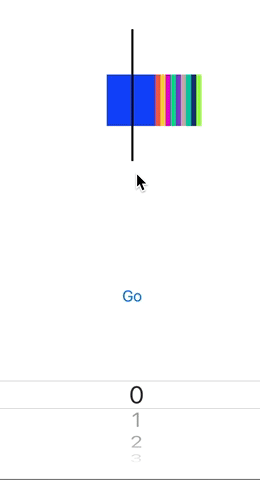使用自定义collectionView布局更改单元格大小时如何使用ScrollToItem(at:)
我有一个collectionView的自定义布局。此自定义布局会增加中心单元的宽度。这是执行此操作的自定义布局类。看一下shiftedAttributes函数,看看它是如何完成的
class CustomCollectionViewLayout: UICollectionViewLayout {
private var cache = [IndexPath: UICollectionViewLayoutAttributes]()
private var contentWidth = CGFloat()
private var visibleLayoutAttributes = [UICollectionViewLayoutAttributes]()
private var oldBounds = CGRect.zero
private var cellWidth: CGFloat = 5
private var collectionViewStartY: CGFloat {
guard let collectionView = collectionView else {
return 0
}
return collectionView.bounds.minY
}
private var collectionViewHeight: CGFloat {
return collectionView!.frame.height
}
override public var collectionViewContentSize: CGSize {
return CGSize(width: contentWidth, height: collectionViewHeight)
}
override public func prepare() {
print("calling prepare")
guard let collectionView = collectionView,
cache.isEmpty else {
return
}
updateInsets()
collectionView.decelerationRate = .fast
cache.removeAll(keepingCapacity: true)
cache = [IndexPath: UICollectionViewLayoutAttributes]()
oldBounds = collectionView.bounds
var xOffset: CGFloat = 0
var cellWidth: CGFloat = 5
for item in 0 ..< collectionView.numberOfItems(inSection: 0) {
let cellIndexPath = IndexPath(item: item, section: 0)
let cellattributes = UICollectionViewLayoutAttributes(forCellWith: cellIndexPath)
cellattributes.frame = CGRect(x: xOffset, y: 0, width: cellWidth, height: collectionViewHeight)
xOffset = xOffset + cellWidth
contentWidth = max(contentWidth,xOffset)
cache[cellIndexPath] = cellattributes
}
}
override func layoutAttributesForElements(in rect: CGRect) -> [UICollectionViewLayoutAttributes]? {
visibleLayoutAttributes.removeAll(keepingCapacity: true)
for (_, attributes) in cache {
visibleLayoutAttributes.append(self.shiftedAttributes(from: attributes))
}
return visibleLayoutAttributes
}
override func layoutAttributesForItem(at indexPath: IndexPath) -> UICollectionViewLayoutAttributes? {
guard let attributes = cache[indexPath] else { fatalError("No attributes cached") }
return shiftedAttributes(from: attributes)
}
override public func shouldInvalidateLayout(forBoundsChange newBounds: CGRect) -> Bool {
if oldBounds.size != newBounds.size {
cache.removeAll(keepingCapacity: true)
}
return true
}
override func invalidateLayout(with context: UICollectionViewLayoutInvalidationContext) {
if context.invalidateDataSourceCounts { cache.removeAll(keepingCapacity: true) }
super.invalidateLayout(with: context)
}
}
extension CustomCollectionViewLayout {
func updateInsets() {
guard let collectionView = collectionView else { return }
collectionView.contentInset.left = (collectionView.bounds.size.width - cellWidth) / 2
collectionView.contentInset.right = (collectionView.bounds.size.width - cellWidth) / 2
}
override func targetContentOffset(forProposedContentOffset proposedContentOffset: CGPoint, withScrollingVelocity velocity: CGPoint) -> CGPoint {
guard let collectionView = collectionView else { return super.targetContentOffset(forProposedContentOffset: proposedContentOffset) }
let midX: CGFloat = collectionView.bounds.size.width / 2
guard let closestAttribute = findClosestAttributes(toXPosition: proposedContentOffset.x + midX) else { return super.targetContentOffset(forProposedContentOffset: proposedContentOffset) }
return CGPoint(x: closestAttribute.center.x - midX, y: proposedContentOffset.y)
}
private func findClosestAttributes(toXPosition xPosition: CGFloat) -> UICollectionViewLayoutAttributes? {
guard let collectionView = collectionView else { return nil }
let searchRect = CGRect(
x: xPosition - collectionView.bounds.width, y: collectionView.bounds.minY,
width: collectionView.bounds.width * 2, height: collectionView.bounds.height
)
let closestAttributes = layoutAttributesForElements(in: searchRect)?.min(by: { abs($0.center.x - xPosition) < abs($1.center.x - xPosition) })
return closestAttributes
}
private var continuousFocusedIndex: CGFloat {
guard let collectionView = collectionView else { return 0 }
let offset = collectionView.bounds.width / 2 + collectionView.contentOffset.x - cellWidth / 2
return offset / cellWidth
}
private func shiftedAttributes(from attributes: UICollectionViewLayoutAttributes) -> UICollectionViewLayoutAttributes {
guard let attributes = attributes.copy() as? UICollectionViewLayoutAttributes else { fatalError("Couldn't copy attributes") }
let roundedFocusedIndex = round(continuousFocusedIndex)
let focusedItemWidth = CGFloat(20)
if attributes.indexPath.item == Int(roundedFocusedIndex){
attributes.transform = CGAffineTransform(scaleX: 10, y: 1)
} else {
let translationDirection: CGFloat = attributes.indexPath.item < Int(roundedFocusedIndex) ? -1 : 1
attributes.transform = CGAffineTransform(translationX: translationDirection * 20, y: 0)
}
return attributes
}
}
以下是包含使用此布局的collectionView的视图控制器:
class ViewController: UIViewController, UICollectionViewDelegate,UICollectionViewDataSource {
func collectionView(_ collectionView: UICollectionView, numberOfItemsInSection section: Int) -> Int {
return 10
}
func collectionView(_ collectionView: UICollectionView, cellForItemAt indexPath: IndexPath) -> UICollectionViewCell {
let cell = customCollectionView.dequeueReusableCell(withReuseIdentifier: "singleCell", for: indexPath)
cell.backgroundColor = UIColor.random()
return cell
}
func numberOfSections(in collectionView: UICollectionView) -> Int {
return 1
}
@IBOutlet weak var picker: UIPickerView!
@IBOutlet weak var customCollectionView: UICollectionView!
override func viewDidLoad() {
super.viewDidLoad()
customCollectionView.delegate = self
customCollectionView.dataSource = self
picker.delegate = self
picker.dataSource = self
// Do any additional setup after loading the view, typically from a nib.
}
@IBAction func goTo(_ sender: Any) {
let indexPath = IndexPath(item: picker.selectedRow(inComponent: 0), section: 0)
customCollectionView.scrollToItem(at: indexPath, at: .centeredHorizontally, animated: true)
}
}
extension ViewController: UIPickerViewDelegate, UIPickerViewDataSource {
func numberOfComponents(in pickerView: UIPickerView) -> Int {
return 1
}
func pickerView(_ pickerView: UIPickerView, numberOfRowsInComponent component: Int) -> Int {
return 10
}
func pickerView(_ pickerView: UIPickerView, titleForRow row: Int, forComponent component: Int) -> String? {
return String(row)
}
}
请注意pickerView,您可以在其中选择一个在goTo按钮中使用的索引以滚动到该索引处的项目。它在起作用:
看看即使我停留在相同的索引上,它如何仍在滚动,而实际上并没有真正滚动到该索引。当我不移动属性(带有shiftedAttributes)并仅在自定义布局中正常返回它们时,scrollTo可以正常工作。
因此,似乎在做scrollToItem(at :)时会使用每个单元格的位置,这会因已转移的属性而感到困惑?当单元格的大小可能更改时,如何滚动到特定索引?
编辑:here是整个项目代码,如果您想自己尝试的话:
1 个答案:
答案 0 :(得分:1)
看来scrollToItem()使用的是固定的布局大小。
我认为您将必须手动计算偏移量并使用setContentOffset()
//To do: Calculate widths of cells up to the cell you want to scroll to
var calculatedOffset: CGFloat
//Then scroll to the offset calculated
customCollectionView.setContentOffset(CGPoint(x: calculatedOffset, y: 0.0), animated: true)
相关问题
- 自定义CollectionView布局 - Apple Doc建议限制单个单元格类型?
- 如何在单元格的末尾添加CollectionView自定义单元格?
- 如何使用一个UIView自定义TableViewCell和CollectionView Cell。
- 当indexHeadersPinToVisibleBounds时,indexPath上的scrollToItem隐藏了标题下的单元格
- 当我使用我的自定义动画(使用我的自定义动画)scrollToItem函数动画时,UICollectionView单元格会消失
- 如何访问自定义CollectionView单元格的初始值设定项?
- 如何设置自定义collectionView单元格框架?
- 如何在Swift中复制/复制自定义collectionview单元格?
- 使用自定义collectionView布局更改单元格大小时如何使用ScrollToItem(at:)
- 如何通过垂直滚动一次显示collectionView单元格一次
最新问题
- 我写了这段代码,但我无法理解我的错误
- 我无法从一个代码实例的列表中删除 None 值,但我可以在另一个实例中。为什么它适用于一个细分市场而不适用于另一个细分市场?
- 是否有可能使 loadstring 不可能等于打印?卢阿
- java中的random.expovariate()
- Appscript 通过会议在 Google 日历中发送电子邮件和创建活动
- 为什么我的 Onclick 箭头功能在 React 中不起作用?
- 在此代码中是否有使用“this”的替代方法?
- 在 SQL Server 和 PostgreSQL 上查询,我如何从第一个表获得第二个表的可视化
- 每千个数字得到
- 更新了城市边界 KML 文件的来源?
